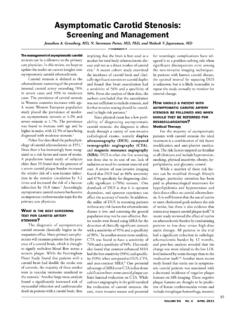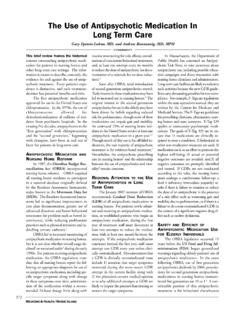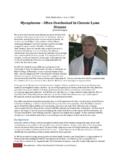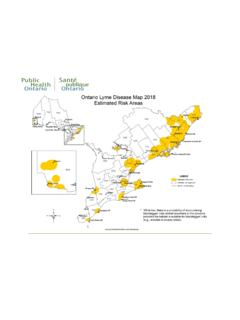Transcription of Cardiac Manifestations of Lyme Disease
1 339 VOLUME 93 NO. 11 NOVEMBER 2010 Cardiac Manifestations of lyme DiseaseThomas J. Earl, MD CASE 1A 15-year old man with no signifi-cant medical history presented to theemergency department following twoepisodes of syncope. He was in his usualstate of good health until earlier on theday of admission when he awoke with asevere headache, shortly followed by asyncopal episode with brief loss of con-sciousness. Later that same day, he expe-rienced a second syncopal episode andsubsequently sought medical arrival to the emergency depart-ment, he was afebrile and hemodynami-cally stable. Physical examination was no-table for irregular and bradycardic heartsounds without murmurs, rubs, or (ECG) (Figure 1) re-vealed complete heart block with a narrowQRS complex.
2 Transthoracicechocardiogram showed normalbiventricular size and function and mildmitral regurgitation. There was no pericar-dial effusion visualized. He was given in-travenous ceftriaxone for presumed Lymecarditis and transferred to the CoronaryCare Unit for monitoring and after admission, telemetrymonitoring revealed progressively lowerheart rates requiring transcutaneous andeventual transvenous pacing. He was con-tinued on ceftriaxone. Subsequent ECGsshowed progression from complete heartblock, to 2:1 atrioventricular (AV) block,and eventually sinus rhythm with firstdegree AV block. (Figure 2) Subsequentlaboratory data revealed elevated LymeIgM and IgG improvement in his nativeconduction the transvenous pacing wirewas removed.
3 He was discharged hometo complete a twenty-eight day courseof ceftriaxone and remained well in 2A 34-year old man with no signifi-cant medical history presented to theemergency department with pleuriticchest pain. Approximately five weeksprior to presentation he developed fevers,a bull s-eye type rash, and Bell s workup at an outside hospitalwas notable for elevated lyme antibodytitres. He was prescribed doxycycline butdiscontinued it after 3 days after experi-encing nausea and presentation to our institution,initial workup was notable for an ECG(Figure 3) showing diffuse, upsloping ST-segment elevations without reciprocaldepressions along with subtle PR-seg-ment depressions. Serial cardiacbiomarkers were negative.
4 Transthoracicechocardiogram revealed normalbiventricular size and systolic functionwithout a pericardial 2. 12-lead ECG showing sinus rhythm with a first-degree AV 1. 12-lead ECG showing complete heart block with a narrow QRS & HEALTH/RHODE ISLAND onstrating prolonged A-H intervals sug-gestive of AV nodal Thereis typically no response to atropine in ac-quired AV block attributed to lyme dis-ease, suggesting direct involvement of theconduction system as opposed to in-creased vagal , acquired AV block inLyme carditis is typically transient andresolves with antibiotic therapy. This isdemonstrated in Case 1 in which a rapidimprovement in native conduction wasobserved. The need for temporary pace-making is not uncommon, but persistentAV block necessitating permanent pace-maker placement is rare.
5 In a retrospec-tive study of 105 patients with docu-mented lyme carditis, 35% of patientsrequired temporary pacing, while onlyfive patients went on to receive a perma-nent pacemaker. Among these patientsreceiving a permanent pacemaker, fourwere noted to have resolution of theirconduction system Disease , while one re-mained conduction system Disease , lyme carditis most commonly manifestsas myopericarditis. Steere et al describedECG abnormalities suggestive of myocar-dial involvement such as ST-segment de-pressions, T-wave inversions, and/or intra-ventricular conduction delays in thirteenof twenty patients. Of note, all of the ob-served abnormalities resolved over , three patients were ob-served to have mild left ventricular (LV)systolic dysfunction by radionuclide im-aging during the active phase of the dis-ease.
6 All had normalization of LV systolicfunction on repeat imaging when the dis-ease was in Several case re-ports and small cohort studies have addi-tionally described patients with clinicaland ECG evidence of , lyme Disease has been purportedto play a causative role in the developmentof a dilated cardiomyopathy and/orchronic congestive heart failure followingsmall European studies showing higherrates of seropositivity in patients with anidiopathic dilated cardiomyopathy as com-pared to controls as well as the ability togrow B burgdorferi from endomyocardialbiopsy specimens taken from a small co-hort of patients with an idiopathic ,13 To date, similarfindings have not been replicated in theUnited his clinical presentation andrecent serologic data he was started onintravenous ceftriaxone for a diagnosis ofLyme pericarditis.
7 Treatment was contin-ued for a total of twenty-eight days. Hewas treated with NSAIDs and opiate an-algesics with eventual relief of his the time of completion of antibiotictherapy he was without chest Disease , a tick-borne illness firstdescribed in Connecticut in 1977, is cur-rently the most commonly reported vec-tor-borne illness in the United States. Inthis country, lyme Disease is caused bythe spirochete Borrelia burgdorferi,which is transmitted by the bite of Ixodestick. According to the Centers for Dis-ease Control and Prevention (CDC), theincidence of lyme Disease in Rhode Is-land in 2008 was (confirmed casesper 100,000 persons), with peak report-ing in the mid and late ,2 The majority of patientspresent with the classic rash of lyme dis-ease, erythema migrans, and/or arthritis,while a small minority experience cardiacmanifestations of the Manifestations of lyme dis-ease are typically seen in the early-dissemi-nated phase (Stage 2) of the illness, withapproximately 5% of untreated patientshaving Cardiac involvement within thefirst few weeks after Disease De-spite a slightly higher incidence of Lymedisease in females, there is a 3.
8 1 male-to-female predominance of lyme spectrum of Cardiac involvement inLyme Disease is highly variable, rangingfrom asymptomatic to severe manifesta-tions. Notably, early recognition of in-fection and prompt administration ofantibiotic therapy is thought to decreasethe likelihood of Cardiac involvement,although to my knowledge there are norandomized trials demonstrating a clini-cal benefit of antibiotics in terms of du-ration or severity of Cardiac Manifestations of lyme carditisinclude syncope or pre-syncope, palpita-tions, dyspnea, and/or chest pain. Car-diac abnormalities in lyme Disease mostcommonly include varying degrees of AVblock and/or et al reported twenty patientswith Cardiac Manifestations of lyme dis-ease in 1980.
9 Within this group, eigh-teen patients developed fluctuating de-grees of AV block, with eight patientsdeveloping complete heart block. Inter-estingly, the degree of AV block was notedto fluctuate even over the course of Electrophysiology studies per-formed on select patients with Lymecarditis from van der Linde s series re-vealed diffuse conduction system involve-ment, with the majority of patients dem-Figure 3. 12-lead ECG showing sinus rhythm with diffuse, upsloping ST-segmentelevations as well PR-segment depressions in the inferior 93 NO. 11 NOVEMBER 2010 The diagnosis of lyme carditis is typi-cally established through a combinationof clinical presentation, serologic data, andnon-invasive Cardiac testing.
10 A directedhistory should focus on potential tick ex-posures as well as current or antecedenterythema migrans. In Steere s cohort, eigh-teen of the twenty patients describederythema migrans at some point in thedisease course, while fifteen had the clas-sic skin manifestation at the time that car-diac involvement was Ofnote, Cardiac Disease as the sole manifesta-tion of lyme Disease has also been Suspicion of lyme carditis isconfirmed with serologic from the Infectious Dis-eases Society of America suggest that pa-tients with lyme Disease and AV blockand/or myopericarditis be treated witheither oral or parenteral antibiotics forfourteen days. For hospitalized patients,a parenteral antibiotic is the preferredinitial choice.





